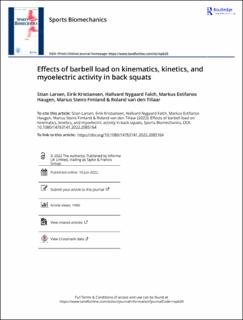| dc.contributor.author | Larsen, Stian | |
| dc.contributor.author | Kristiansen, Eirik Lindset | |
| dc.contributor.author | Falch, Hallvard Nygaard | |
| dc.contributor.author | Haugen, Markus Estifanos | |
| dc.contributor.author | Fimland, Marius Steiro | |
| dc.contributor.author | van den Tillaar, Roland Johannes Wilhelmus | |
| dc.date.accessioned | 2023-02-10T13:41:24Z | |
| dc.date.available | 2023-02-10T13:41:24Z | |
| dc.date.created | 2022-09-13T12:36:29Z | |
| dc.date.issued | 2022 | |
| dc.identifier.citation | Larsen, S., Kristiansen, E., Falch, H. N., Haugen, M. E., Fimland, M. S. & van den Tillaar, R. (2022). Effects of barbell load on kinematics, kinetics, and myoelectric activity in back squats. Sports Biomechanics. doi: | en_US |
| dc.identifier.issn | 1752-6116 | |
| dc.identifier.uri | https://hdl.handle.net/11250/3050067 | |
| dc.description.abstract | Shortly after beginning the upward phase of a free-weight barbell back squat there is often a deacceleration phase (sticking region) that may lead to repetition failure. The cause for this region is not well understood. Therefore, this study investigated the effects of 90%, 100%, and 102% of 1-RM barbell loads on kinematics, kinetics, and myoelectric activity in back squats. Twelve resistance-trained healthy males (body mass: 83.5 ± 7.8 kg, age: 27.3 ± 3.8 years, height: 180.3 ± 6.7 cm) participated in the study and lifted 134 ± 17 kg at 90% and 149 ± 19 kg at 100%, while they failed at 153 ± 19 kg with 102% load. The main findings were that barbell displacement and barbell velocity in the sticking region decreased with increasing loads. Moreover, the external hip extensor moment increased with heavier loads, whereas the knee extension and ankle plantarflexion moments were similar during the concentric phase. Also, reduced hip and knee extension together with lower myoelectric activity for all hip extensors and vastus lateralis were found for the 102% load compared to the others. Our finding suggests that the increased external hip extensor moment together with lower hip extensor myoelectric activity due to a reduced hip extension and thereby are responsible for lifting failure among resistance-trained males. | en_US |
| dc.language.iso | eng | en_US |
| dc.publisher | Taylor & Francis | en_US |
| dc.rights | Attribution-NonCommercial-NoDerivatives 4.0 Internasjonal | * |
| dc.rights.uri | http://creativecommons.org/licenses/by-nc-nd/4.0/deed.no | * |
| dc.title | Effects of barbell load on kinematics, kinetics, and myoelectric activity in back squats | en_US |
| dc.type | Peer reviewed | en_US |
| dc.type | Journal article | en_US |
| dc.description.version | publishedVersion | en_US |
| dc.rights.holder | © 2022 The Authors | en_US |
| dc.source.pagenumber | 15 | en_US |
| dc.source.journal | Sports Biomechanics | en_US |
| dc.identifier.doi | 10.1080/14763141.2022.2085164 | |
| dc.identifier.cristin | 2051181 | |

